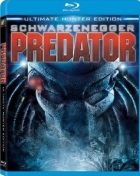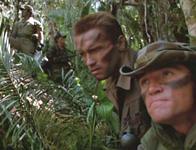Predator [Blu-Ray]
|
Of course, that's how they start off. When the movie opens, a special team of commandos led by Schwarzenegger's Major "Dutch" Schaeffer is flown into an unnamed South American country to lead a rescue mission to reclaim some high-profile hostages from a band of guerillas hidden deep in the jungle. Tensions rise early when Dutch is outranked by Maj. Dillon (Carl Weathers), a soldier-turned-bureaucratic pencil pusher who isn't to be trusted because he wears a tie. Dutch's team, on the other hand, is a motley assortment of über-masculine soldier types who wouldn't be caught dead in a tie, including Bill Duke's Mac, who relives tension by running a disposable razor up and down his face; Sonny Landham's Billy, a Native American tracker; and Jesse "Don't Call Me ‘The Body'" Ventura's Blain, who carries a massive machine gun that looks like it should be outfitted on the side of a tank. The rescue operation doesn't exactly go according to plan, but it does allow the movie to divulge in plenty of explosive pyrotechnics and ruthless gunning down of the South American guerillas, who are never given any ideological impetus for their actions; rather, they're just game pieces to be knocked down by the American soldiers. Screenwriters Jim Thomas and John Thomas, who later penned scripts for Executive Decision (1996) and Wild Wild West (1999) among others, eventually reveal that the so-called rescue mission was not exactly that, which plays as a stark reminder of the Reagan era's legacy of violent, covert noodling south of the border. But, any sustained critique of such activity is roughly on par with the fantasy bureaucratic stonewalling to hide POWs in Rambo: First Blood Part II (1985) and is quickly subsumed by the movie's action-oriented obligations. As it turns out, there is something else in the jungle besides interchangeable guerillas: an invisible alien predator that begins picking off the returning U.S. soldiers one by one. Slowed down by a resilient female guerilla hostage (Elpidia Carrillo), the soldiers become easy prey, especially since they are slow to realize that they are dealing with something nonhuman. The rest of the movie sustains a nicely realized dance between the increasingly desperate commandos--stripped of their physical and military superiority, they have to resort to any trick they can just to stay alive--and the brutal Predator, who mixes futuristic technology (laser gun, invisibility cloak) with a taste for sadistic rituals that primarily involve disemboweling and skinning its victims. The fact that the Predator is never given any reason for its presence on earth makes its hunting seem all the more ruthless, and the point-of-view shots we get through its eyes where everything is seen as variable electronic hues representing heat neatly mimics the monster's mindset by reducing the characters to faceless victims. Despite being little more than a man in a rubber suit that bleeds glowing green highlighter ink, the Predator itself is a marvelous creation engineered by effects maestro Stan Winston (with some input from Aliens director James Cameron). It's a creepy combination of insect, reptile, and professional wrestler with inexplicable dreadlocks. Played by Kevin Peter Hall, who stands an imposing seven feet two inches, the Predator has enough physical presence to overcome the basic simplicity of its outward appearance. Not surprisingly, the movie eventually boils down to a mano-a-mano standoff between Schwarzenegger and the Predator, with the stakes more even when Dutch discovers his own path to invisibility. It is here that Predator really announces its affinity for all things primeval, as Dutch, stripped of his guns and armor, has to reach deep inside himself and become a primordial warrior--caked head-to-toe in mud and bearing homemade spears and a bow and arrows, he is primal man writ large (the enormity of Schwarzenegger's muscular bulk at this point in his career is still jaw-dropping). Predator was director John McTiernan's sophomore project (following the atmospheric horror movie Nomads, which he wrote and directed the previous year), and it kicked off his brief standing atop the American action-directing heap (his follow-up projects were 1988's Die Hard and 1990's The Hunt for Red October, after which came the debacle that was 1993's Last Action Hero). In Predator we can see his recognizable style taking shape, particularly his elegant tracking shots and his love affair with rack focus. At its heart, Predator is little more than an overstuffed classic B-movie concept; one can almost imagine it having been made 30 years earlier in black and white with a more rubbery monster. Yet, McTiernan's style elevates it to something more, even when the dictates of the Schwarzenegger movie, including bad puns following violent action, threaten to drag it down where it belongs.
Copyright ©2010 James Kendrick All images Copyright © 20th Century Fox Home Entertainment | |||||||||||||||||||||||||||||||||||
Overall Rating:



 (3.5)
(3.5)
Subscribe and Follow
Get a daily dose of Africa Leader news through our daily email, its complimentary and keeps you fully up to date with world and business news as well.
News RELEASES
Publish news of your business, community or sports group, personnel appointments, major event and more by submitting a news release to Africa Leader.
More Information

 Predator is perhaps the perfect 1980s movie, melding as it does the three most popular mainstream genres of that decade: action/adventure, science fiction, and horror, specifically slasher horror--and it's an Arnold Schwarzenegger movie to boot. It takes all those components and mixes them up into a heady brew of violent action setpieces, hammy dialogue, macho posturing, and point-of-view stalking that twists everything around by making the prey not nubile, half-naked teenagers at a summer camp, but rather a group of special-ops bad-asses who in any other movie would be the aggressors.
Predator is perhaps the perfect 1980s movie, melding as it does the three most popular mainstream genres of that decade: action/adventure, science fiction, and horror, specifically slasher horror--and it's an Arnold Schwarzenegger movie to boot. It takes all those components and mixes them up into a heady brew of violent action setpieces, hammy dialogue, macho posturing, and point-of-view stalking that twists everything around by making the prey not nubile, half-naked teenagers at a summer camp, but rather a group of special-ops bad-asses who in any other movie would be the aggressors.